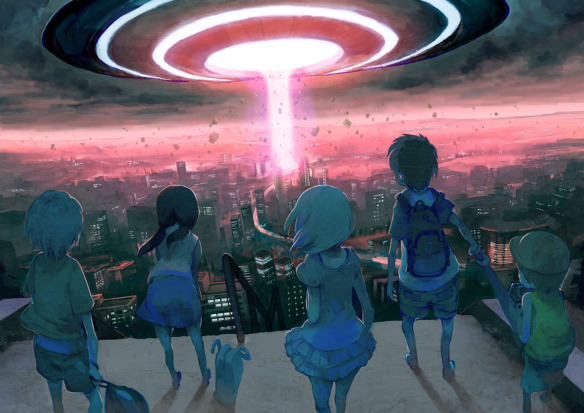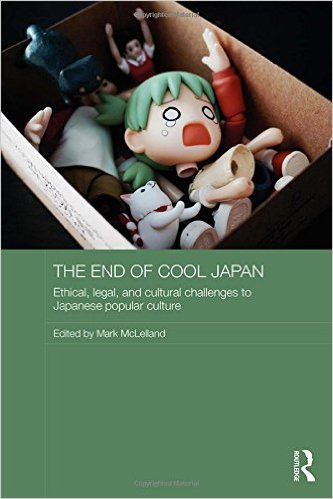Books: The End of Cool Japan
August 22, 2016 · 2 comments
By Jonathan Clements.
 From its cheeky, quirky cover, to the selection of its contributors, to its unifying tone, Mark McLelland’s new anthology deserves to shoot right to the top of Japanese Studies reading lists. The End of Cool Japan: Ethical, Legal and Cultural Challenges to Japanese Popular Culture offers a vital and timely warning for all those students who think that scholarship amounts to a diary of what they did at the weekend.
From its cheeky, quirky cover, to the selection of its contributors, to its unifying tone, Mark McLelland’s new anthology deserves to shoot right to the top of Japanese Studies reading lists. The End of Cool Japan: Ethical, Legal and Cultural Challenges to Japanese Popular Culture offers a vital and timely warning for all those students who think that scholarship amounts to a diary of what they did at the weekend.
The very idea of “Cool Japan” has been attractive to anyone in the field – after all, who wouldn’t like the assertion that the trend-setters were all into their specialty? But there have been gripes about the concept ever since it was first introduced. Takashi Murakami devastatingly dismissed it as “little more than ad copy to allow public funds to go to advertising companies,” while I have previously commented on the irony of multi-million yen subsidies for corporations while anime creators have to crowd-source their rent. Meanwhile, Shinji Oyama entertainingly set the cat among the pigeons at an event in Edinburgh, when he derided “Cool Japan” as a flimsy veneer of big eyes and rainbow hair, slapped inexpertly onto the same old same-old.
 Editor McLelland notes the uneasy difference between, say, a Japanese studio’s notion of cool, which amounts to asking you to buy its products, and that of the Bit Torrent generation, who don’t want to pay for anything. Coolness, as he points out, is a term that usually implies the disapproval of authority, and Cool Japan derives its name, at least in part, from a grim-faced, law-abiding Japanese government intellectual property initiative. “Cool” is hence a dangerous word to throw around in the company of teenagers who would rather steal their media than pay for it. Or on a lesser but still persuasive level, what if “cool” resides not in the original products, but in the manner in which those products are subverted by their users?
Editor McLelland notes the uneasy difference between, say, a Japanese studio’s notion of cool, which amounts to asking you to buy its products, and that of the Bit Torrent generation, who don’t want to pay for anything. Coolness, as he points out, is a term that usually implies the disapproval of authority, and Cool Japan derives its name, at least in part, from a grim-faced, law-abiding Japanese government intellectual property initiative. “Cool” is hence a dangerous word to throw around in the company of teenagers who would rather steal their media than pay for it. Or on a lesser but still persuasive level, what if “cool” resides not in the original products, but in the manner in which those products are subverted by their users?
McLelland’s foreword suggests that Japanese Studies risks becoming caught up in a giddy, self-regarding babble about how Japanese popular culture is taking the world by storm, foregrounding press releases ahead of hard data, and mistaking cosplay for commentary. Such an idea is far from crazy – the original Ghost in the Shell only ran in Tokyo movie theatres for a fortnight, and yet it is held up worldwide as an icon of Japanese cinema. Thanks in particular to the rise of Fan Studies, it has become all too easy for the Western pundit to lock themselves in a convention-centred hugbox in which “everybody they know” thinks that anime and manga are the bee’s knees. Then, someone ruins their day by giving them the actual sales figures for, say, Rumic World or Tokyo Godfathers. Not that sales figures should be the sole determinant for avenues of academic enquiry, but if someone is setting themselves up as an expert in what is “popular”, they’d better have some idea what that actually means.
Alisa Freedman’s chapter on Death Note is smartly placed at the front of the book, where its opening crawl of Japanese pop culture high-points from the last thirty years can serve as a reminder to readers of how much has changed. She notes that the Japanese government’s sudden push for soft power ironically came at the same moment that institutions lost much of their control over the distribution and revenue collection from their products, which could often migrate informally and out of context. Even as the Japanese authorities tried to declare what cool was, a 14-year-girl in Pennsylvania was caught writing the name of Justin Bieber in her notebook, in the hope that a Gothic death-god would smite him. Neither the American nor the Japanese authorities thought this was remotely cool, but I bet a bunch of other schoolkids did. Meanwhile, Death Note’s occult leanings led to its banning in north-east China – deliciously ironic, as it turned out that it was not actually legally available there anyway.
Six of the ten chapters touch in some way on issues of censorship or erotica, which has long been seen as both a component of and a threat towards Japan’s supposed coolness. Several authors deal with the problems faced by researchers and consumers of pornography – Sharalyn Orbaugh on the tribulations of Canadian hentai fans, for example, Adam Stapleton on Australian seizures of “contentious images”, or Ling Yang and Yanrui Xu on the fate of Chinese boys-love fangirls amid a Communist censorship clampdown. Mark McLelland points to the ramifications of such issues for writing on Japan, including journalists desperate for something to be offended by, and academics sucked into the narrative by hacks in search of a soundbite. “These encounters,” writes McLelland, “rarely end well.” Meanwhile Kristine M. Santos and Febriani Sihombing identify one of the ironies of post-colonial discourse, which is that even as Japanese culture is celebrated in America for its hybridity and newness, there are critics in Indonesia who regard it as an unwelcome form of cultural imperialism. Whose cool?
Others enunciate the problem that pop culture researchers have in being taken seriously, not only by their peers, but also by their students and the public. Patrick W. Galbraith finds himself at the sharper end of such concerns, where his daring to investigate “Lolita Complex” manga risks being forever marked as “the Lolicon guy,” a form of career suicide. Kirsten Cather, whose work on Japanese censorship I have covered elsewhere, has a humdinger about a “fun” exercise in which each of four professors are asked to imagine they are trapped in an overcrowded lifeboat, and must explain why they should not be thrown overboard. Laura Miller points to laziness among students that are unwilling to apply academic tools to topics that they are only “studying” because they were already consuming them. She wittily deconstructs the hypocrisies of institutions that claim to be all for Japanese popular culture, such as the local politicians that would just love a tea ceremony, but clutch their pearls in horror at the thought of a maid café, and the Japanese who regard themselves as arbiters of Japanese-ness, brooking no discussion of other Japanese people who are not like them.
Miller observes that a curriculum designed solely to meet with the approval of a notional “normal” Japanese man in the street would be a disservice to foreign students, but I would have loved to see someone grapple with the likely result! It would be a marvellous torture, for an evil Japanese Studies professor from the Mirror Universe, to force her students to watch 24 Eyes instead of The Seven Samurai; Sazae-san instead of Evangelion; to read a translation of Dan Brown rather than the Japanese author of the moment; and to view some god-awful chat show crammed with talentless, braying talento instead of the stuff her students were actually enjoying. Perhaps some cruel lecturer would like to consider it as a classroom exercise: what is really popular in Japanese popular culture, and how does that correlate, if at all, to what the fans are watching?
I cannot recommend this book highly enough, to libraries, lecturers and students. As I have noted before elsewhere, however, Routledge’s budgeting seems to aim solely for a readership of eccentric millionaires. I shall give them the benefit of the doubt and assume that the £90 cover price for this book reflects the parlous state of Japanese Studies, particularly in the United Kingdom, where despite all the talk of Cool Japan, perilously few new students dare to go £30,000 in debt for the privilege of leaping blindfolded into the choppy waters of one of the world’s most difficult languages. Disappointingly, the book also lacks real page numbers on the Kindle, which one would rather hope Routledge would spring for with a £34.99 price tag. There’s nothing cool about that.
Jonathan Clements is the author of Modern Japan: All That Matters.
anime, books, censorship, hentai, Japan, Japanese Studies, Jonathan Clements, lolicon, manga
Feckless Cartoon Nob
August 26, 2016 1:35 am
At a mere three days, as of this post, it looks like this is your most-read commentary on this blog. The long reach of Cool Japan in action? Any future Chinese animation posts may require a similar hammer hed of "Cool China" to elicit views.
Jonathan Clements
August 26, 2016 4:41 am
You may be right, Feckless Cartoon Nob, although without checking, I believe that our most read post was actually the obituary for Bruce Lewis, which has had over 5,000 visitors: http://blog.alltheanime.com/bruce-lewis-1965-2016/